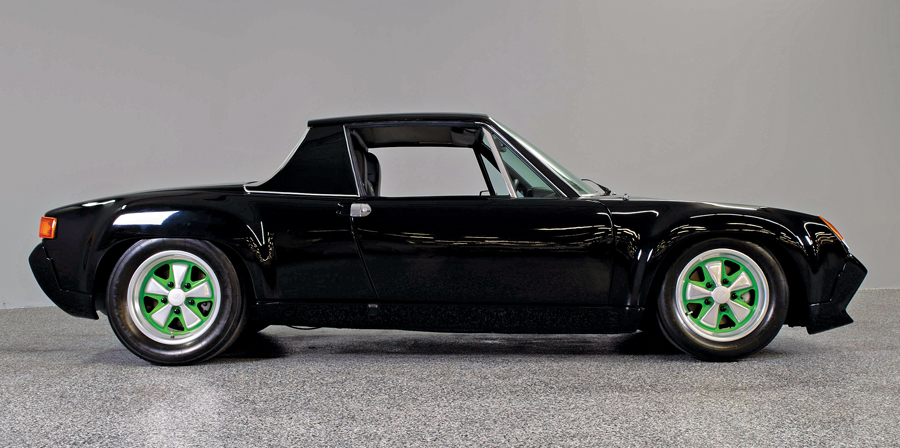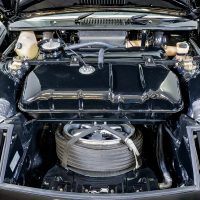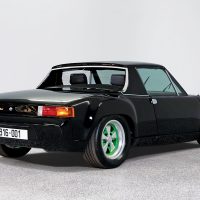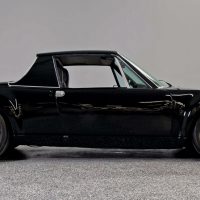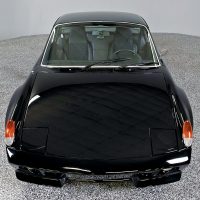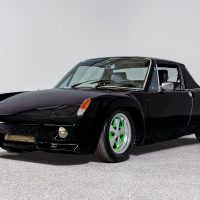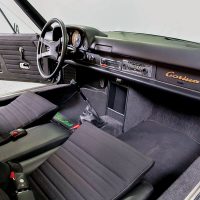SCM Analysis
Detailing
| Vehicle: | 1971 Porsche 916 Prototype “Brutus” |
| Years Produced: | 1971 |
| Number Produced: | One prototype plus 10 “production” cars |
| Original List Price: | New 916, DM 45,000, or about $16,500; Porsche first sold “Brutus” as a used car for DM 27,500, or about $10,000 |
| SCM Valuation: | $1,052,909 (this car) |
| Tune Up Cost: | $1,000 with valve adjustment |
| Chassis Number Location: | Stamping top of inside right front fender under hood, metal plate on right-side headlight housing |
| Engine Number Location: | Vertical fan support, driver’s side, facing left |
| Club Info: | Porsche Club of America |
| Website: | http://www.pca.org |
| Alternatives: | 1968–73 Ferrari 365 GTB/4, 1970–73 Maserati Ghibli SS, 1971–72 BMW 3.0 CSL |
| Investment Grade: | A |
This car, Lot 124, sold for $1,052,909, including buyer’s premium, at the Artcurial Rétromobile auction in Paris, FRA, on February 8, 2019.
As I have written recently, 914s — once the dumpy little two-box orphan of a joint venture between Porsche and Volkswagen — are climbing the collector ladder of desirability. As evidence, this article will be the third on a 914 in the past eight issues of SCM.
Escalating 914 prices
There are more 914s coming to auction — with escalating prices countering the trend of a softer market for many Porsches. That 914/6s are collectible is not really a surprise because they were true Porsches in design — and assembly — and were built in small quantities in 1970–72 with just 3,332 units.
The 1970–75 914/4, on the other hand, was assembled in a Volkswagen plant and numbered 115,644 units. A lot of that is proving to be irrelevant, however, as an original 914/4 in Ravenna Green with 17,000 miles sold for $89,600, including a 12% buyer’s premium, at Bonhams’ Amelia Island sale on March 7, 2019.
The 914/6 has long been collectible
That said, the 914/6 has always been the cognoscenti’s 914, and the 914/6 GT is the really desirable uber-model. But wait, there also are the 11 916s — the unicorn Porsche that many collectors would love to have.
The dark blue Porsche 916 showed up at a dealer’s stand at Essen’s Techno-Classica about five years ago. My good friend, owner of over 50 street and race 911s of all variants, really wanted it. On opening day we were standing next to it early in the morning — and breathing hard.
We stood around, trying to look disinterested, while a German gentleman and his son talked with the dealer’s sales manager. Before we had said “hello,” they closed a deal for huge money — and ruined our week.
Born amid a history of VW-Porsche cooperation
Designed at Porsche and built in a Karmann plant on contract, the 914 provided VW with a sportier replacement for the aging Karmann Ghia Type 34 and Porsche with an entry-level car to replace the 4-cylinder 912. The 914/4s had 4-cylinder VW Type 4 engines of 1.7, 1.8 or 2.0 liters. They were assembled at VW with a Volkswagenwerk nameplate and VW serial number.
The 914/6s had 6-cylinder 911T engines of 2.0 liters, assembled by Baur and Porsche on a VW/Karmann-supplied tub with a Porsche AG nameplate and Porsche serial number. Porsche sold both cars in the United States as Porsches, while VW dealers sold the “Volkswagen-Porsche” 914/4 in the rest of the world.
A mutually beneficial relationship
Porsche and Volkswagen had a long, positive history. In 1948, VW Chairman Heinz Nordhoff began paying Porsche a design royalty for every “Beetle” sold. In 1953, Nordhoff and Ferry Porsche agreed on a broad-ranging engineering consultancy. Those funds were critical to the viability of the fledgling Porsche firm.
A handshake agreement gone awry
The 914 joint venture was largely a handshake deal between Nordhoff and Ferry Porsche. When Nordhoff died in 1968, VW’s new chairman was not so enamored of the deal and subsequent negotiations to save it required Porsche to pay more for their 914/6 tubs.
That higher price foreshadowed doom for Porsche 914/6s, as their retail price was only about $500 beneath the 911T, while the outward resemblance to the much-less-expensive 914/4 kept potential 914/6 buyers at bay.
A “super” 914/6
The 914/6 died in a management decision in late 1971, although a few more 914/6s were made and sold in 1972. However, a year before they killed the model, Porsche engineers were still infatuated with the mid-engine design with its superb handling characteristics. To improve the breed and help sales, they planned a new super 914/6, and dubbed it a “916” — a marketing term, not a Porsche engineering “Type” designation.
Meaningful upgrades vs. the 914/6
The 916 was uprated in almost every area, with a 2,341-cc (1972–73 911S) engine of 190 horsepower and a Type 915 5-speed gearbox. The body featured one-piece fiberglass bumpers/fascias with a center-mounted oil cooler in front, a welded-on steel roof, wide flares over seven-inch Fuchs wheels with 185 Michelins, sway bars at both ends, and Bilstein competition shocks.
The 916 weighed 165 pounds less than a 911S and was the best-performing Porsche of the era, going 0–60 mph in under seven seconds and with a top speed of 146 mph. The 1972 911S had numbers of 7.8 seconds and 142 mph.
Porsche killed the 916
Unfortunately, the 916 was really expensive, about 50% more than MSRP for a 911S. A couple of weeks before they planned to introduce the 916 at the October 1971 Paris Auto Show, Porsche canceled the model. The performance overlap with their core-model 911, the huge price discrepancy and minimal profitability killed the 916. Only 11 cars were eventually built — happily now for the few collectors who have one.
The Piëch family’s 916 prototype
In mid-1970, as Porsche engineers were contemplating the 916, engineering director Ferdinand Piëch (Ferry Porsche’s nephew, Porsche racing chief, and later VW chairman) ordered that a prototype be built.
It was uprated over even 916 specifications with an RSR engine, a smaller competition fuel tank and a more luxurious interior.
When the 916 project died, the factory-owned car was loaned to Piëch’s first wife, Corina (von Planta) Piëch — not to his 1960-born daughter Corina, as is often written. Piëch’s wife nicknamed the car “Brutus,” reportedly because of either its aggressive appearance or, more likely, its replacement 2.9-liter race engine. Corina had the styling department execute several changes to the interior, and the car was labeled “Brutus” on its rear deck lid and “Corina” on the glovebox door.
The later history of “Brutus”
Porsche sold the 916 prototype to a Colonel Hartvigsen in April 1974, after which a major mechanical overhaul was done at the factory. Hartvigsen brought the car to the U.S. in late 1978 and kept it until his death. It was then stored for years before more recently moving through two collectors.
The second of those later owners commissioned a full restoration of what had become a dilapidated 916. Known experts executed and advised on the mechanical and cosmetic restorations. After completion, “Brutus” was displayed at the 2017 Amelia Island Concours in 2017, then at Porsche’s U.S. headquarters in Atlanta, and lastly at the Petersen Museum’s exhibition, ”The Porsche Effect.”
Brutus at auction scores a big sale
At their Rétromobile auction, Artcurial pre-sale estimated “Brutus” at $930,000 to $1,400,000. Artcurial thought that a prototype 916 with Piëch family connections was a premium piece of merchandise.
It sold for $1,052,909, including buyer’s premium. We know of two 916s that are potentially buyable. Those owners have been asking over $1,000,000. This prototype was perhaps a bit of a deal given the 2.9 engine and Piëch provenance. ♦
